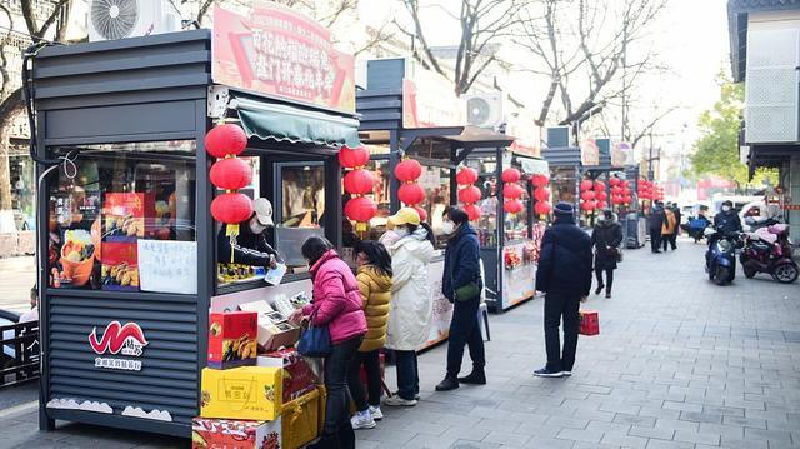China and Covid19
Infants with Covid-19 Separated from Parents: Shanghai ‘Baby Quarantine Site’ Sparks Online Anger
Many Weibo users think it is unnecessarily cruel for young children to be kept separate from their parents at this Shanghai quarantine location.
Published
2 years agoon
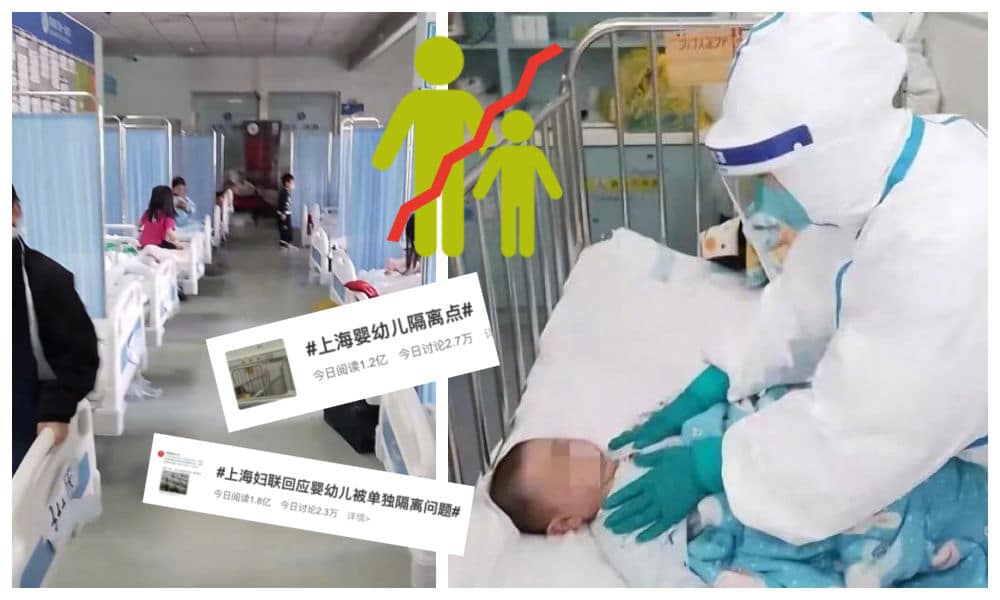
Young children who tested positive for Covid-19 are separated from their parents at an infant quarantine site in Shanghai’s Jinshan District – even if the parents also tested positive for Covid. On social media, many find these anti-epidemic measures incomprehensible and “inhumane.”
On Friday, April 1st, photos and videos of an alleged quarantine site in Shanghai where babies and small children are kept in isolation – separated from their parents – went viral on Chinese social media. As some photos and videos showed multiple children together in one hospital bed, some crying incessantly, many people were concerned and angry, especially when it was rumored that there were only ten nurses to look after 200 babies.

The topic attracted much attention amidst lockdowns and heightened epidemic panic in Shanghai, where on Friday alone the city reported 6311 new Covid-19 cases, of which 270 symptomatic and 6051 asymptomatic.
A video uploaded to TikTok was alleged to show the isolated minors at the Shanghai Public Health Clinical Center. The kids (including one 58-day-old) who tested positive were separated from parents. 10 nurses are taking care of 200 kids. The original video has now been removed. pic.twitter.com/OA9BCfmtpi
— Chu Yang (@ChuYang_Journ) April 1, 2022
On April 2nd, the Shanghai Public Health Clinical Center and Shanghai Women’s Association responded to the viral photos and videos showing unaccompanied children at alleged Covid-19 isolation sites. Speaking to China Philanthropist (中国慈善家), the Women’s Association expressed concerns about the situation and said that they were taking action to “coordinate” the situation. By Saturday afternoon, a hashtag related to the issue received over 180 million views on Weibo (#上海妇联回应婴幼儿被单独隔离问题#).
The same day, the Shanghai Public Health Clinical Center stated that the photos and videos circulating online were from its pediatric ward in Shanghai’s Jinshan District, emphasizing that these were scenes from the ward in the process of “adjusting and improving” their hospital environment due to an increase in child patients with Covid-19. They said the videos and photos were not of the Jinshan “baby quarantine site,” but they did not provide further details.
Since the Center also did not directly respond to the issue of children and parents being separated, many netizens were not satisfied with the official response at all. “It doesn’t matter, [what matters is that] you can’t separate children from their parents,” one top commenter replied.
A report issued by Reuters on Saturday confirmed that the Shanghai Public Health Clinical Center in the city’s Jinshan District does have a quarantine site for children who tested positive for Covid-19, and that parents are not allowed to accompany the children – regardless of whether or not they also tested positive for Covid-19.
In light of the online discussions about the children’s isolation site, China Newsweek published photos on Weibo showing the actual circumstances of the infant quarantine area of the Shanghai Public Health Clinical Center (images below).
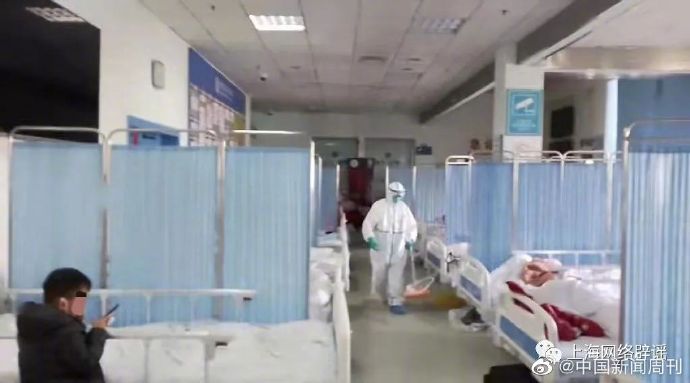
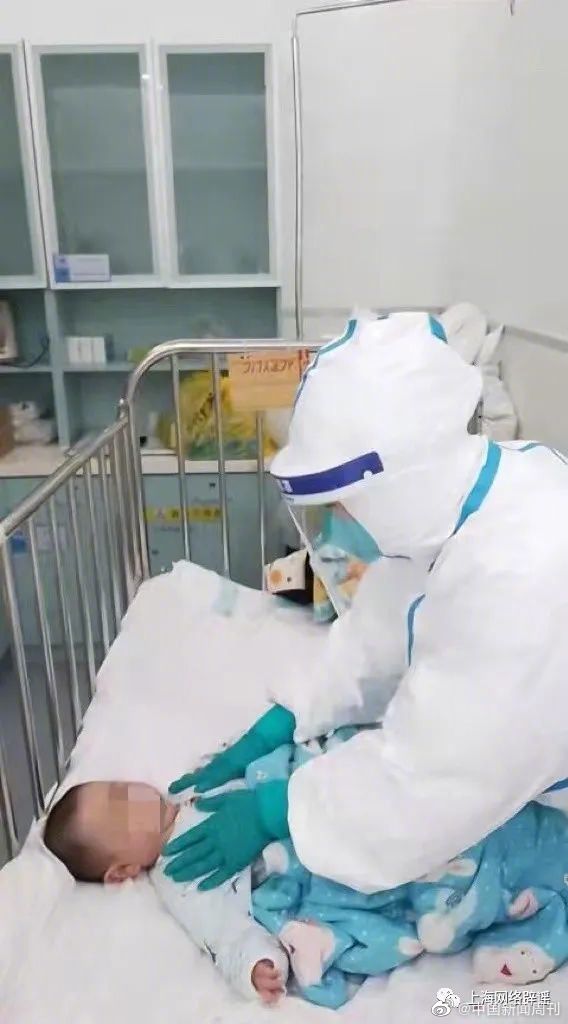
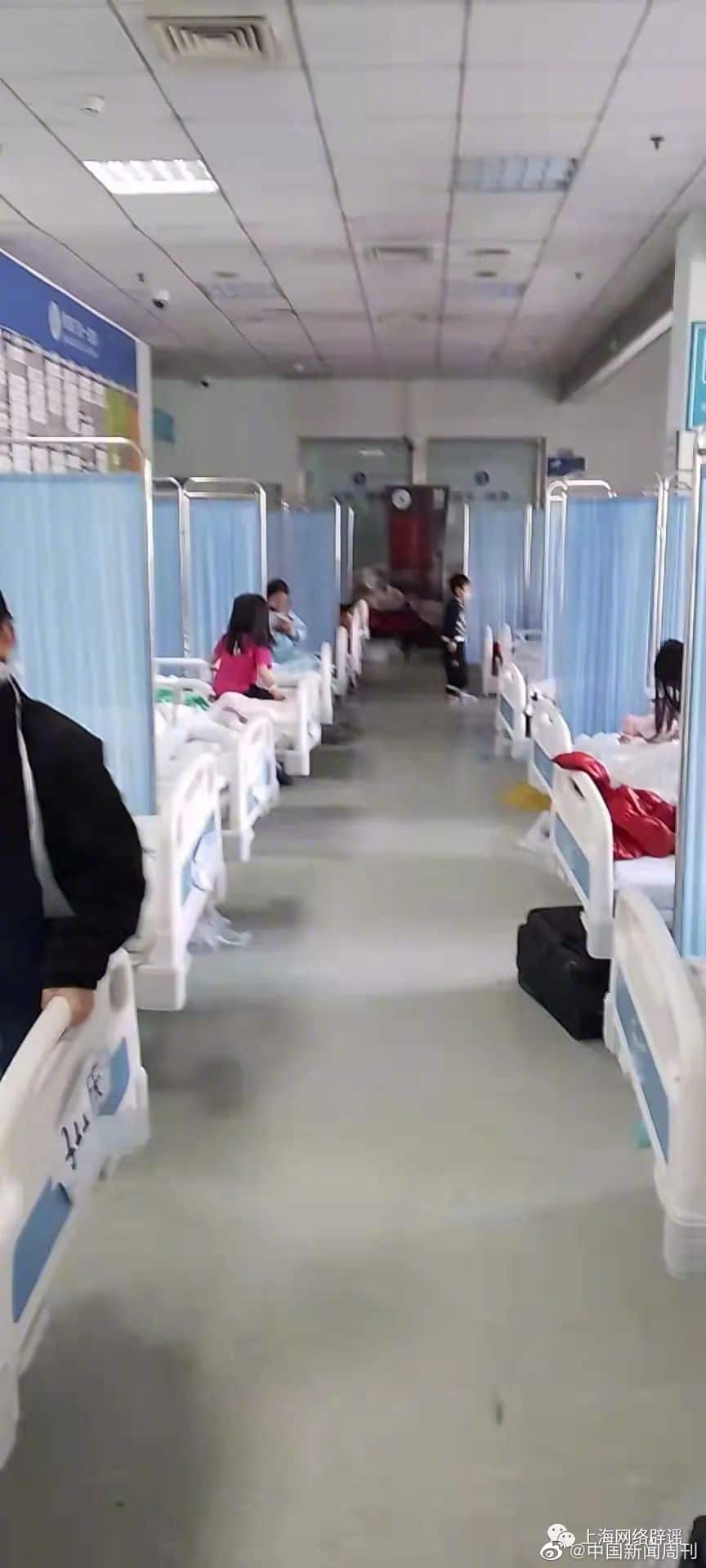
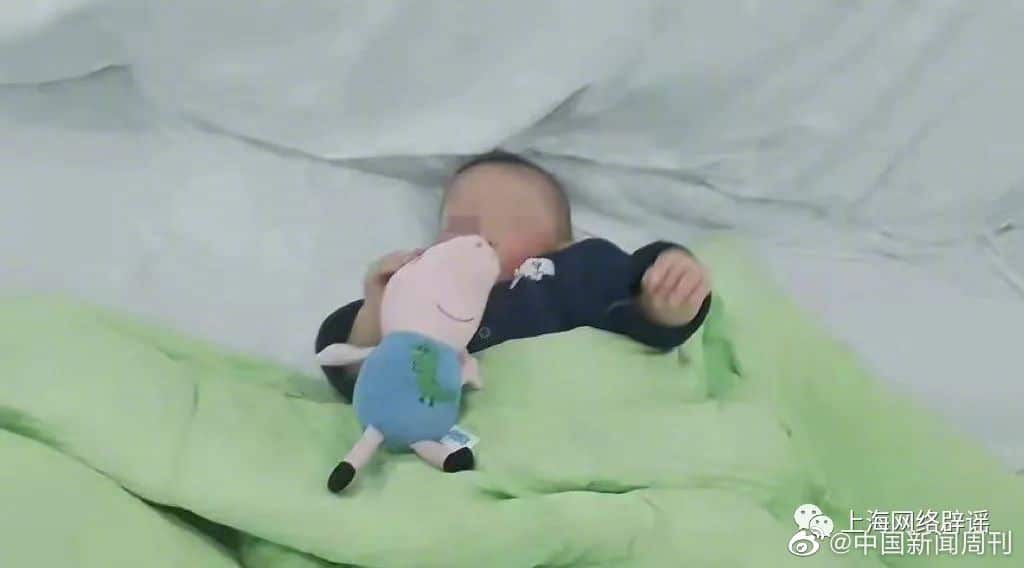
Although the post was supposedly meant to ‘debunk’ the ongoing rumors about the infant quarantine site, it did not seem to subside the online storm. One popular comment said: “This is the current situation? This is miserable. To be so young and without parents, even in concentration camps the kids and parents stay together.”

China Newsweek also published a story about a Shanghai mother being separated from her 2-year-old daughter after they both tested positive for Covid-19. Ms. Zhu and her child were initially transferred to Tongren Hospital on March 26, but two days later, Ms. Zhu was sent to a temporary Covid-19 field hospital while her daughter was sent to the Jinshan location. Although a chat group was set up to inform the mother of her daughter’s wellbeing, she was barely kept up to date on how her child was doing at all.
“Why can’t they just stay together? The child is just two years old!”, one person wrote. “I don’t understand the logic behind these ‘infant centralized isolation sites,'” one popular Weibo account (@云无心45) with over 4,5 million followers wrote:
“1. If the child is positive [for Covid-19], and the parents are also positive, why can’t they all quarantine together?
2. If the child is positive, but the parents are negative, let one parent stay with the child, and just add one infected person for the sake of ensuring the child’s wellbeing. Or, at the very least, at least give parents the option of looking after their own child at the isolation location.
3. If the parents are infected but the child isn’t, then it’s necessary to separate the parents and children for the sake of the child’s health.”
Others called the infant isolation sites “insane” and “inhuman.” Official channels did not provide any answers on why children and parents were being separated.
Sudden, sharp separation between parents and infants can harm and even alter a young child’s physical and emotional development. According to Jacek Debiec, Assistant Professor in the Department of Psychiatry at the University of Michigan, any serious and prolonged disruption of parental care, especially in very young children, changes how the young brain develops. In this article for The Conversation, Debiec claims that young children experience a spike in stress levels when they suddenly can not rely on their parents’ presence and care anymore. According to studies, even short, abrupt separations can have a negative impact on a child’s brain.
“These kids are getting a lifelong trauma, and so are their parents,” a Weibo user named ‘Sonia’ wrote.
“It’s ok for adults to go through some hardship, but it’s not ok for kids, especially not for infants,” one woman from Shanghai writes: “Shanghai’s disease prevention policy has gone the wrong way (..), it breaks my heart.”
Others on Weibo comment on the difference in Covid-19 measures between Shanghai ad other cities: “In Shenzhen people could even quarantine together with their pets, can you imagine? The disparity is so huge, it’s inconceivable.”
In January of this year, when Xi’an was fighting against a Covid-19 outbreak, news of a 3-year-old child being taken away after testing positive for Covid-19 went viral online (see tweet below).
This little guy tested positive for covid in Xi’an, here’s him getting transferred to a designated hospital, probably feeling big, big feelings while wearing a big, big hazmat suit. pic.twitter.com/InTgvdMkiw
— Manya Koetse (@manyapan) January 7, 2022
At the time, the child’s quarantine and treatment drew the attention of netizens who felt for the little patient, but the story was not controversial – the hospital ended up placing the 3-year-old old in the same ward as his mother.
The Shanghai ‘infant quarantine site’, on the other hand, is even controversial after an official explanation was provided in light of the videos and photos. One Weibo commenter responded:
“As someone who used to work for the media, I’m already trying as much as possible to rationally look at the news and stay calm and analytical. But, I’m sorry, I’m also a mom. This afternoon, the so-called mainstream media in big litters said they “debunked” the content below, but what exactly did they refute? Did they refute that this wasn’t happening at Jinshan? What exactly does the simple sentence of ‘care for life is guaranteed’ promise? If the online rumors that there are only two nurses to take care of dozens of children are not true, then how many nurses are taking care of so many children? How do you achieve the “strengthening of communication between children and parents”? How do you communicate that to children who are just a few months old? They have a fever, they are thirsty, their diapers won’t stay on, they have a rash that itches, they can’t talk, how do you make sure they are taken care of?”
Among hundreds of comments, many outraged and many sad, there are also a lot of comments that are short and clear: “Just bring the children back to their mums.”
Update April 6: Shanghai officially announced that parents can apply to accompany their children during central quarantine after signing an agreement, regardless of whether they’ve tested positive for the virus or not. Read more on this policy change here at Shanghai Daily.
To read more about online responses to the Covid-19 measures in Shanghai, click here.
By Manya Koetse
Get the story behind the hashtag. Subscribe to What’s on Weibo here to receive our weekly newsletter and get access to our latest articles:
Spotted a mistake or want to add something? Please let us know in comments below or email us. First-time commenters, please be patient – we will have to manually approve your comment before it appears.
©2022 Whatsonweibo. All rights reserved. Do not reproduce our content without permission – you can contact us at info@whatsonweibo.com.
Manya Koetse is the founder and editor-in-chief of whatsonweibo.com. She is a writer, public speaker, and researcher (Sinologist, MPhil) on social trends, digital developments, and new media in an ever-changing China, with a focus on Chinese society, pop culture, and gender issues. She shares her love for hotpot on hotpotambassador.com. Contact at manya@whatsonweibo.com, or follow on Twitter.

Also Read
China and Covid19
Sick Kids, Worried Parents, Overcrowded Hospitals: China’s Peak Flu Season on the Way
“Besides Mycoplasma infections, cases include influenza, Covid-19, Norovirus, and Adenovirus. Heading straight to the hospital could mean entering a cesspool of viruses.”
Published
8 months agoon
November 22, 2023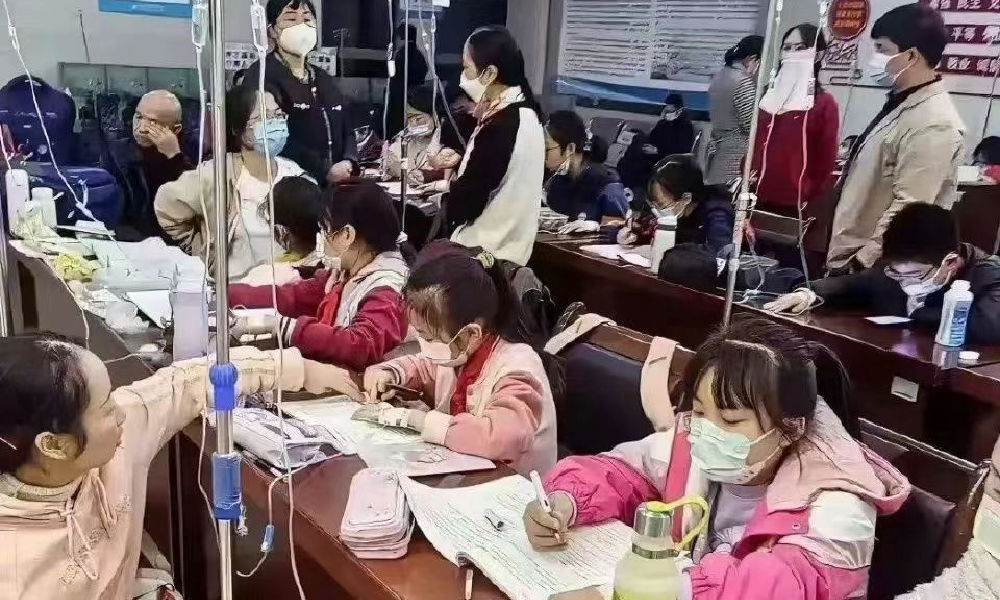
In the early morning of November 21, parents are already queuing up at Xi’an Children’s Hospital with their sons and daughters. It’s not even the line for a doctor’s appointment, but rather for the removal of IV needles.
The scene was captured in a recent video, only one among many videos and images that have been making their rounds on Chinese social media these days (#凌晨的儿童医院拔针也要排队#).
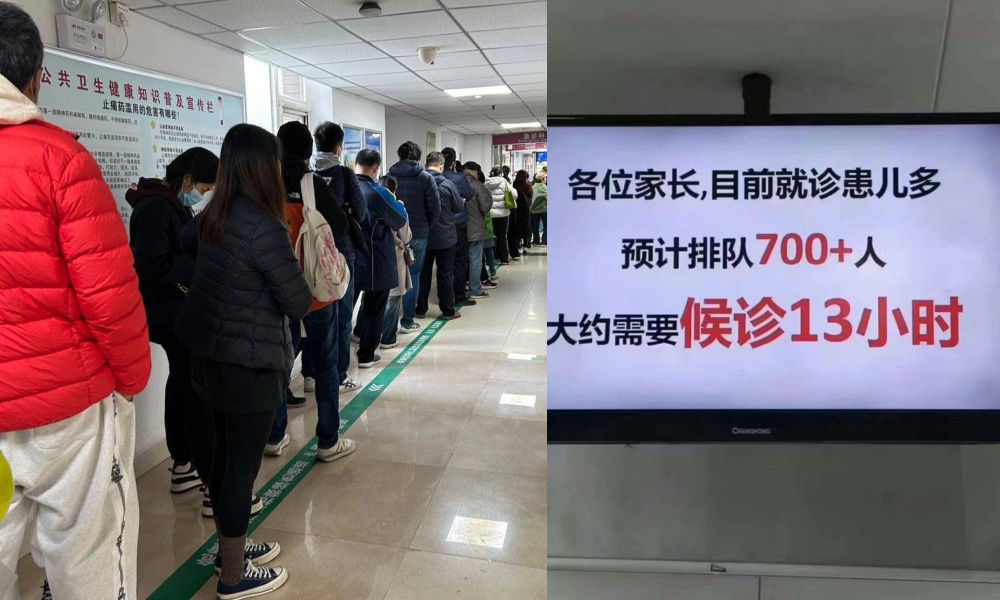
One photo shows a bulletin board at a local hospital warning parents that over 700 patients are waiting in line, estimating a waiting time of more than 13 hours to see a doctor.
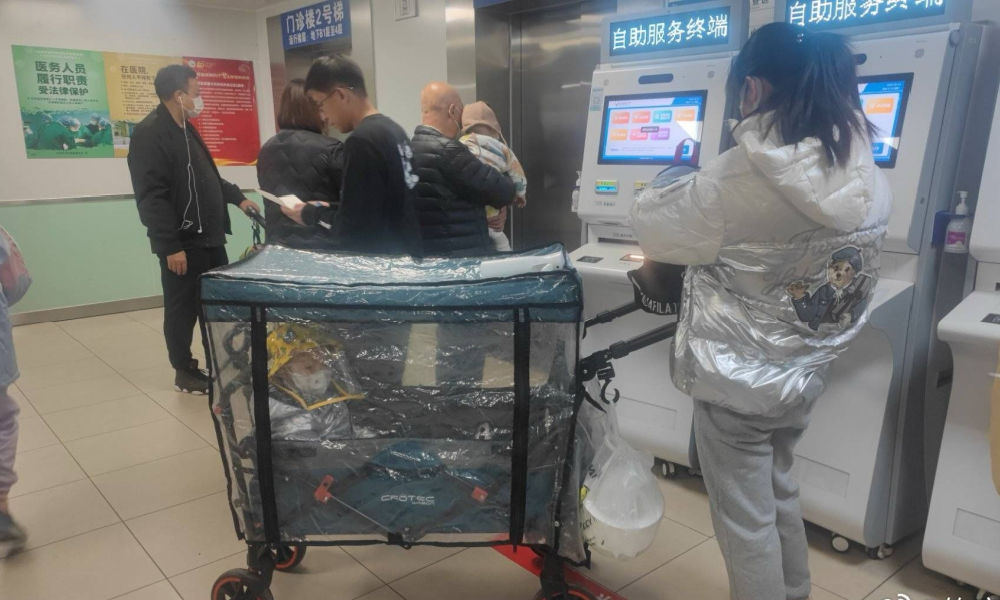
Another image shows children doing their homework while hooked up on an IV.
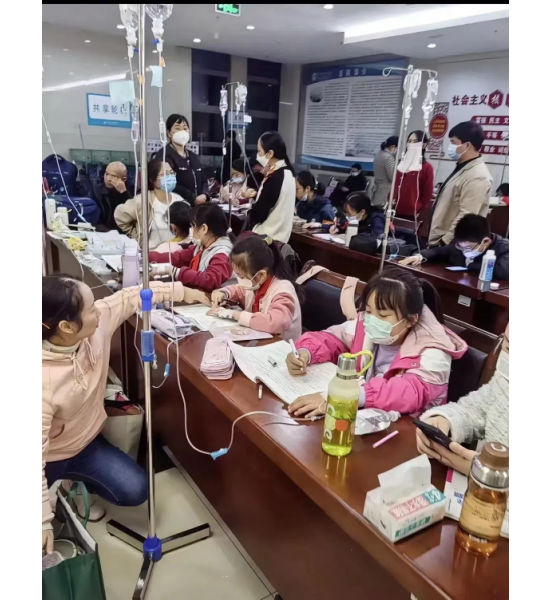
Recent discussions on Chinese social media platforms have highlighted a notable surge in flu cases. The ongoing flu season is particularly impacting children, with multiple viruses concurrently circulating and contributing to a high incidence of respiratory infections.
Among the prevalent respiratory infections affecting children are Mycoplasma pneumoniae infections, influenza, and Adenovirus infection.
The spike in flu cases has resulted in overcrowded children’s hospitals in Beijing and other Chinese cities. Parents sometimes have to wait in line for hours to get an appointment or pick up medication.
According to one reporter at Haibao News (海报新闻), there were so many patients at the Children’s Hospital of Capital Institute of Pediatrics (首都儿科研究所) on November 21st that the outpatient desk stopped accepting new patients by the afternoon. Meanwhile, 628 people were waiting in line to see a doctor at the emergency department.
Reflecting on the past few years, the current flu season marks China’s first ‘normal’ flu peak season since the outbreak of Covid-19 in late 2019 / early 2020 and the end of its stringent zero-Covid policies in December 2022. Compared to many other countries, wearing masks was also commonplace for much longer following the relaxation of Covid policies.
Hu Xijin, the well-known political commentator, noted on Weibo that this year’s flu season seems to be far worse than that of the years before. He also shared that his own granddaughter was suffering from a 40 degrees fever.
“We’re all running a fever in our home. But I didn’t dare to go to the hospital today, although I want my child to go to the hospital tomorrow. I heard waiting times are up to five hours now,” one Weibo user wrote.
“Half of the kids in my child’s class are sick now. The hospital is overflowing with people,” another person commented.
One mother described how her 7-year-old child had been running a fever for eight days already. Seeking medical attention on the first day, the initial diagnosis was a cold. As the fever persisted, daily visits to the hospital ensued, involving multiple hours for IV fluid administration.
While this account stems from a single Weibo post within a fever-advice community, it highlights a broader trend: many parents swiftly resort to hospital visits at the first signs of flu or fever. Several factors contribute to this, including a lack of General Practitioners in China, making hospitals the primary choice for medical consultations also in non-urgent cases.
There is also a strong belief in the efficacy of IV infusion therapy, whether fluid-based or containing medication, as the quickest path to recovery. Multiple factors contribute to the widespread and sometimes irrational use of IV infusions in China. Some clinics are profit-driven and see IV infusions as a way to make more money. Widespread expectations among Chinese patients that IV infusions will make them feel better also play a role, along with some physicians’ lacking knowledge of IV therapy or their uncertainty to distinguish bacterial from viral infections (read more here)
To prevent an overwhelming influx of patients to hospitals, Chinese state media, citing specialists, advise parents to seek medical attention at the hospital only for sick infants under three months old displaying clear signs of fever (with or without cough). For older children, it is recommended to consult a doctor if a high fever persists for 3 to 5 days or if there is a deterioration in respiratory symptoms. Children dealing with fever and (mild) respiratory symptoms can otherwise recover at home.
One Weibo blogger (@奶霸知道) warned parents that taking their child straight to the hospital on the first day of them getting sick could actually be a bad idea. They write:
“(..) pediatric departments are already packed with patients, and it’s not just Mycoplasma infections anymore. Cases include influenza, Covid-19, Norovirus, and Adenovirus. And then, of course, those with bad luck are cross-infected with multiple viruses at the same time, leading to endless cycles. Therefore, if your child experiences mild coughing or a slight fever, consider observing at home first. Heading straight to the hospital could mean entering a cesspool of viruses.”
The hashtag for “fever” saw over 350 million clicks on Weibo within one day on November 22.
Meanwhile, there are also other ongoing discussions on Weibo surrounding the current flu season. One topic revolves around whether children should continue doing their homework while receiving IV fluids in the hospital. Some hospitals have designated special desks and study areas for children.
Although some commenters commend the hospitals for being so considerate, others also remind the parents not to pressure their kids too much and to let them rest when they are not feeling well.
Opinions vary: although some on Chinese social media say it's very thoughtful for hospitals to set up areas where kids can study and read, others blame parents for pressuring their kids to do homework at the hospital instead of resting when not feeling well. pic.twitter.com/gnQD9tFW2c
— Manya Koetse (@manyapan) November 22, 2023
By Manya Koetse, with contributions from Miranda Barnes
Get the story behind the hashtag. Subscribe to What’s on Weibo here to receive our newsletter and get access to our latest articles:
Spotted a mistake or want to add something? Please let us know in comments below or email us. First-time commenters, please be patient – we will have to manually approve your comment before it appears.
©2023 Whatsonweibo. All rights reserved. Do not reproduce our content without permission – you can contact us at info@whatsonweibo.com.
China and Covid19
Repurposing China’s Abandoned Nucleic Acid Booths: 10 Innovative Transformations
Abandoned nucleic acid booths are getting a second life through these new initiatives.
Published
1 year agoon
May 19, 2023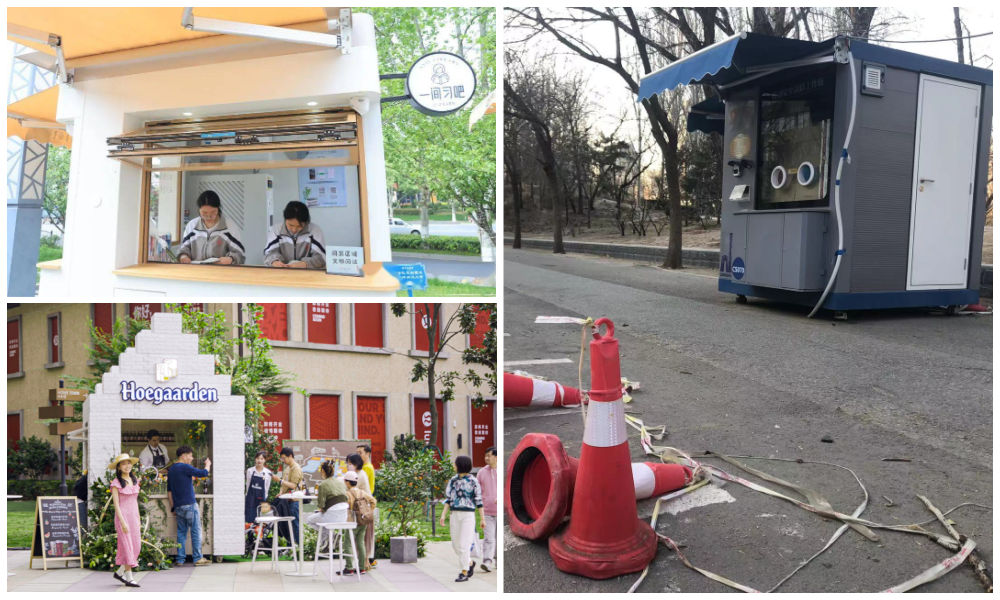
During the pandemic, nucleic acid testing booths in Chinese cities were primarily focused on maintaining physical distance. Now, empty booths are being repurposed to bring people together, serving as new spaces to serve the community and promote social engagement.
Just months ago, nucleic acid testing booths were the most lively spots of some Chinese cities. During the 2022 Shanghai summer, for example, there were massive queues in front of the city’s nucleic acid booths, as people needed a negative PCR test no older than 72 hours for accessing public transport, going to work, or visiting markets and malls.
The word ‘hésuān tíng‘ (核酸亭), nucleic acid booth (also:核酸采样小屋), became a part of China’s pandemic lexicon, just like hésuān dìtú (核酸地图), the nucleic acid test map lauched in May 2022 that would show where you can get a nucleic test.
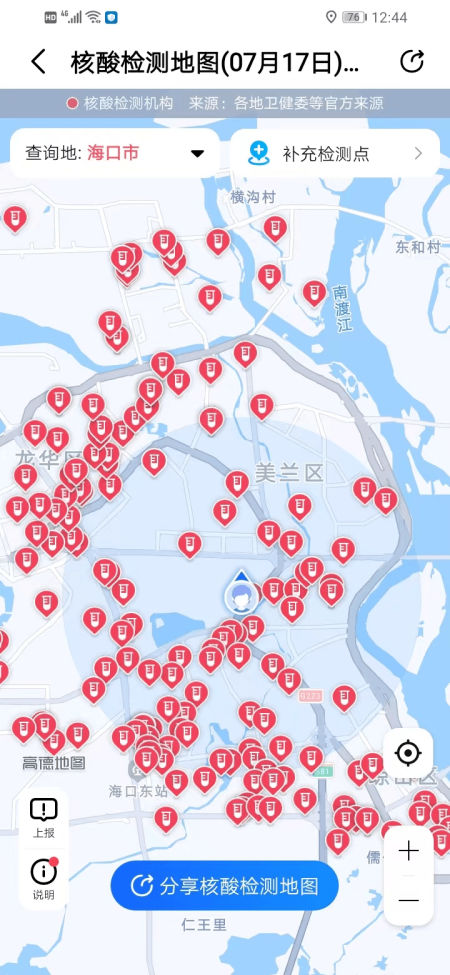
Example of nucleic acid test map.
During Halloween parties in Shanghai in 2022, some people even came dressed up as nucleic test booths – although local authorities could not appreciate the creative costume.
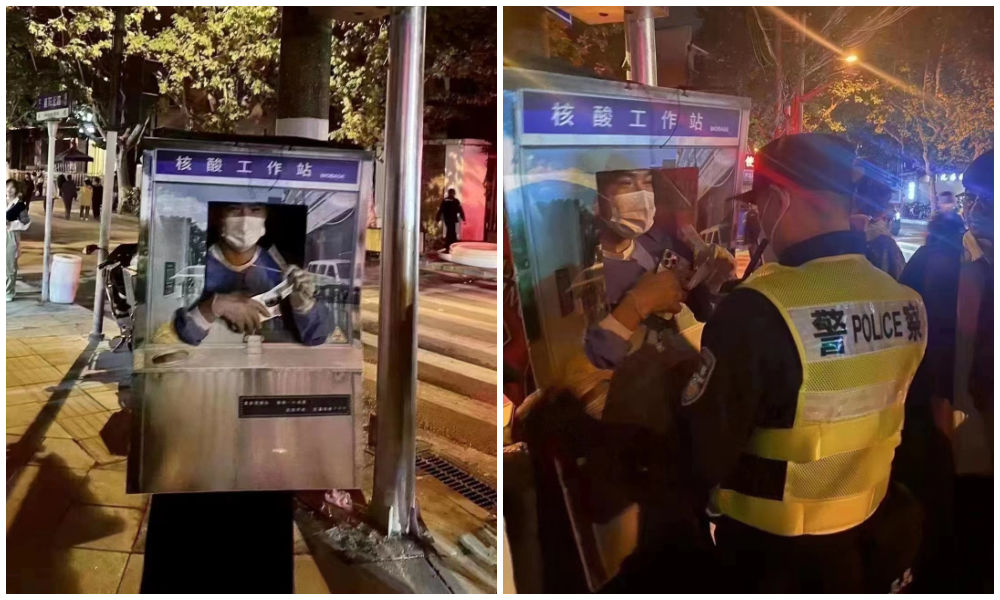
Halloween 2022: dressed up as nucliec acid booths. Via @manyapan twitter.
In December 2022, along with the announced changed rules in China’s ‘zero Covid’ approach, nucleic acid booths were suddenly left dismantled and empty.
With many cities spending millions to set up these booths in central locations, the question soon arose: what should they do with the abandoned booths?
This question also relates to who actually owns them, since the ownership is mixed. Some booths were purchased by authorities, others were bought by companies, and there are also local communities owning their own testing booths. Depending on the contracts and legal implications, not all booths are able to get a new function or be removed yet (Worker’s Daily).
In Tianjin, a total of 266 nucleic acid booths located in Jinghai District were listed for public acquisition earlier this month, and they were acquired for 4.78 million yuan (US$683.300) by a local food and beverage company which will transform the booths into convenience service points, selling snacks or providing other services.
Tianjin is not the only city where old nucleic acid testing booths are being repurposed. While some booths have been discarded, some companies and/or local governments – in cooperation with local communities – have demonstrated creativity by transforming the booths into new landmarks. Since the start of 2023, different cities and districts across China have already begun to repurpose testing booths. Here, we will explore ten different way in which China’s abandoned nucleic test booths get a second chance at a meaningful existence.
1: Pharmacy/Medical Booths
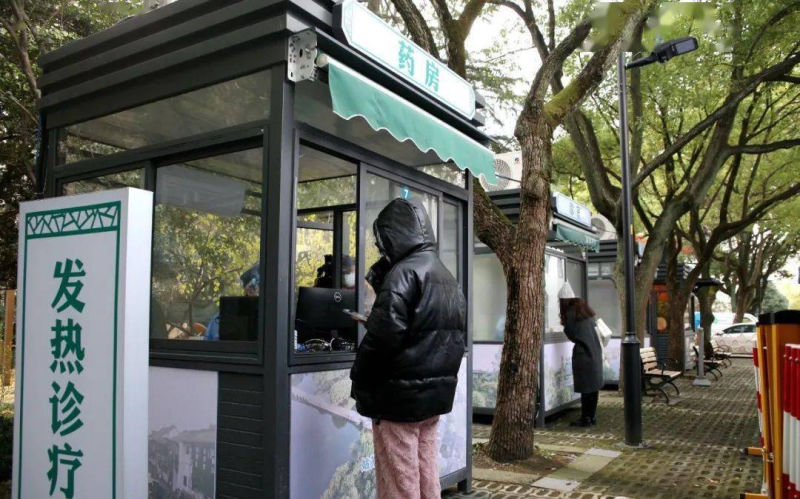
Via ‘copyquan’ republished on Sohu.
Blogger ‘copyquan’ recently explored various ways in which abandoned PCR testing points are being repurposed.
One way in which they are used is as small pharmacies or as medical service points for local residents (居民医疗点). Alleviating the strain on hospitals and pharmacies, this was one of the earliest ways in which the booths were repurposed back in December of 2022 and January of 2023.
Chongqing, Tianjin, and Suzhou were among earlier cities where some testing booths were transformed into convenient medical facilities.
2: Market Stalls
In Suzhou, Jiangsu province, the local government transformed vacant nucleic acid booths into market stalls for the Spring Festival in January 2022, offering them free of charge to businesses to sell local products, snacks, and traditional New Year goods.
The idea was not just meant as a way for small businesses to conveniently sell to local residents, it was also meant as a way to attract more shoppers and promote other businesses in the neighborhood.
3: Community Service Center
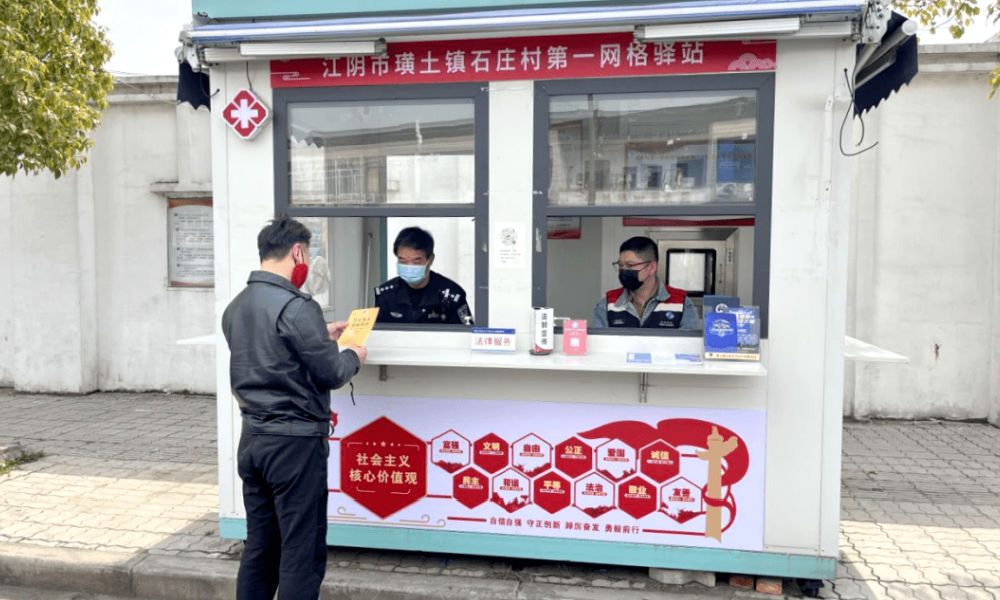
Small grid community center in Shizhuang Village, image via Sohu.
Some residential areas have transformed their local nucleic acid testing booths into community service centers, offering all kinds of convenient services to neighborhood residents.
These little station are called wǎnggé yìzhàn (网格驿站) or “grid service stations,” and they can serve as small community centers where residents can get various kinds of care and support.
4: “Refuel” Stations
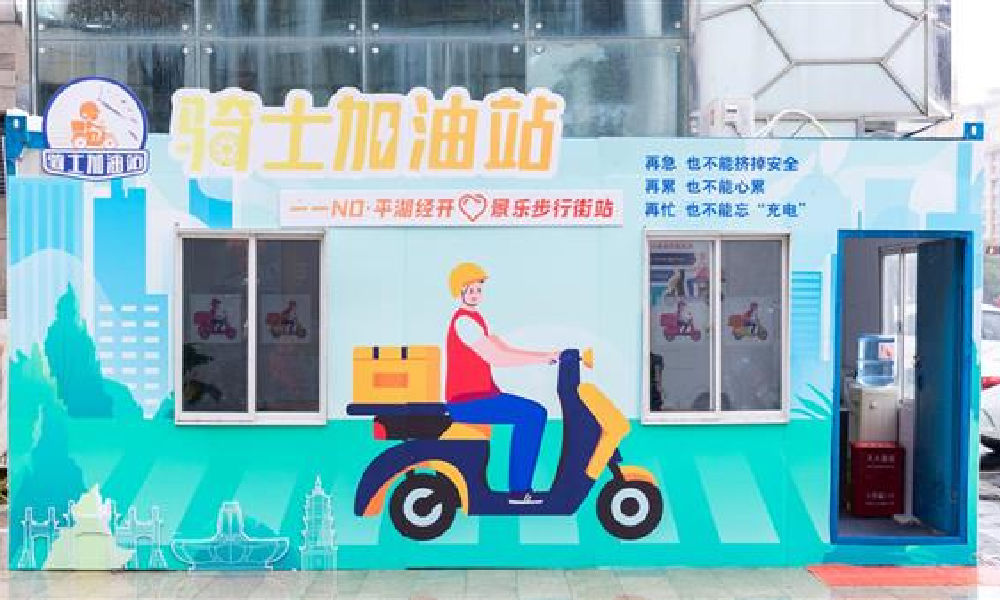
In February of this year, 100 idle nucleic acid sampling booths were transformed into so-called “Rider Refuel Stations” (骑士加油站) in Zhejiang’s Pinghu. Although it initially sounds like a place where delivery riders can fill up their fuel tanks, it is actually meant as a place where they themselves can recharge.
Delivery riders and other outdoor workers can come to the ‘refuel’ station to drink some water or tea, warm their hands, warm up some food and take a quick nap.
5: Free Libraries
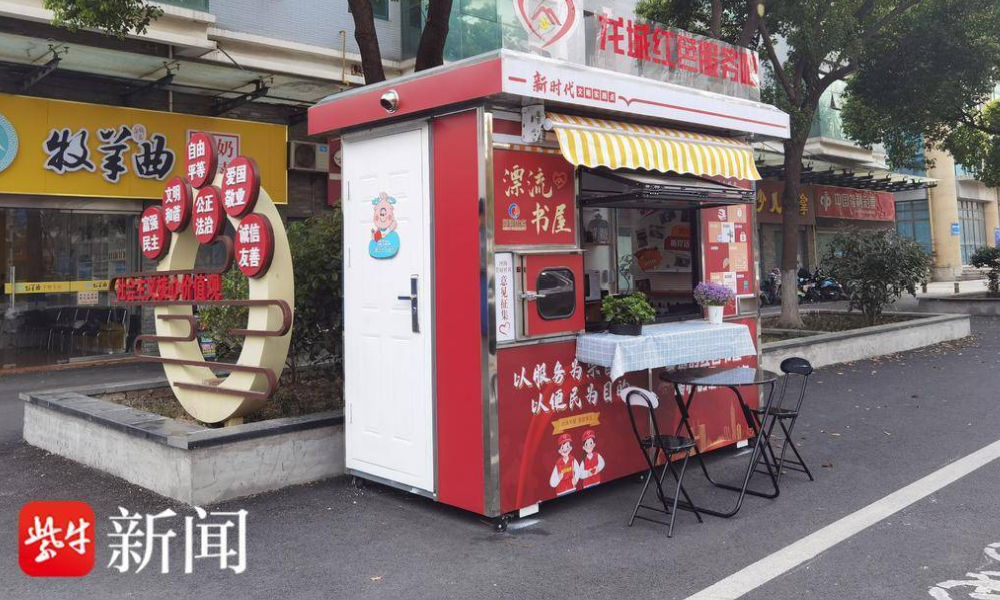
image via sohu.
In various Chinese cities, abandoned nucleic acid booths have been transformed into little free libraries where people can grab some books to read, donate or return other books, and sit down for some reading.
Changzhou is one of the places where you’ll find such “drifting bookstores” (漂流书屋) (see video), but similar initiatives have also been launched in other places, including Suzhou.
6: Study Space
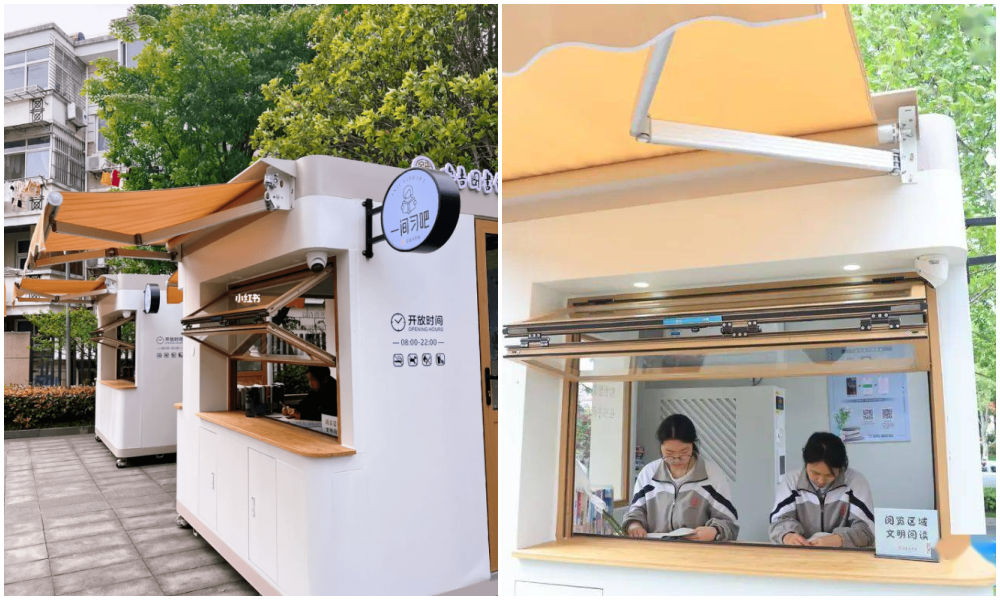
Photos via Copyquan’s article on Sohu.
Another innovative way in which old testing points are being repurposed is by turning them into places where students can sit together to study. The so-called “Let’s Study Space” (一间习吧), fully airconditioned, are opened from 8 in the morning until 22:00 at night.
Students – or any citizens who would like a nice place to study – can make online reservations with their ID cards and scan a QR code to enter the study rooms.
There are currently ten study booths in Anji, and the popular project is an initiative by the Anji County Library in Zhejiang (see video).
7: Beer Kiosk
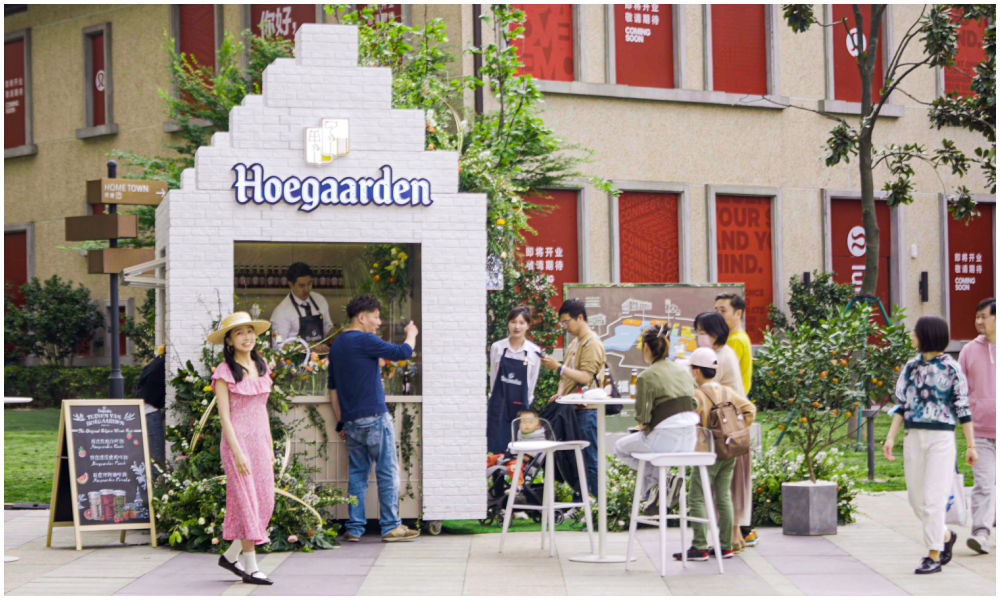
Hoegaarden beer shop, image via Creative Adquan.
Changing an old nucleic acid testing booth into a beer bar is a marketing initiative by the Shanghai McCann ad agency for the Belgium beer brand Hoegaarden.
The idea behind the bar is to celebrate a new spring after the pandemic. The ad agency has revamped a total of six formr nucleic acid booths into small Hoegaarden ‘beer gardens.’
8: Police Box
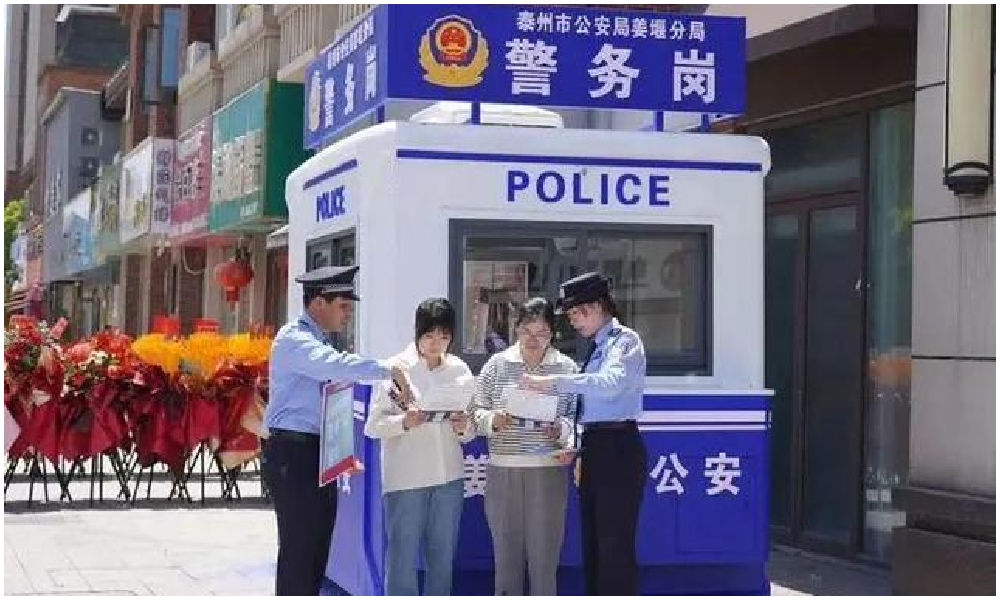
In Taizhou City, Jiangsu Province, authorities have repurposed old testing booths and transformed them into ‘police boxes’ (警务岗亭) to enhance security and improve the visibility of city police among the public.
Currently, a total of eight vacant nucleic acid booths have been renovated into modern police stations, serving as key points for police presence and interaction with the community.
9: Lottery Ticket Booths
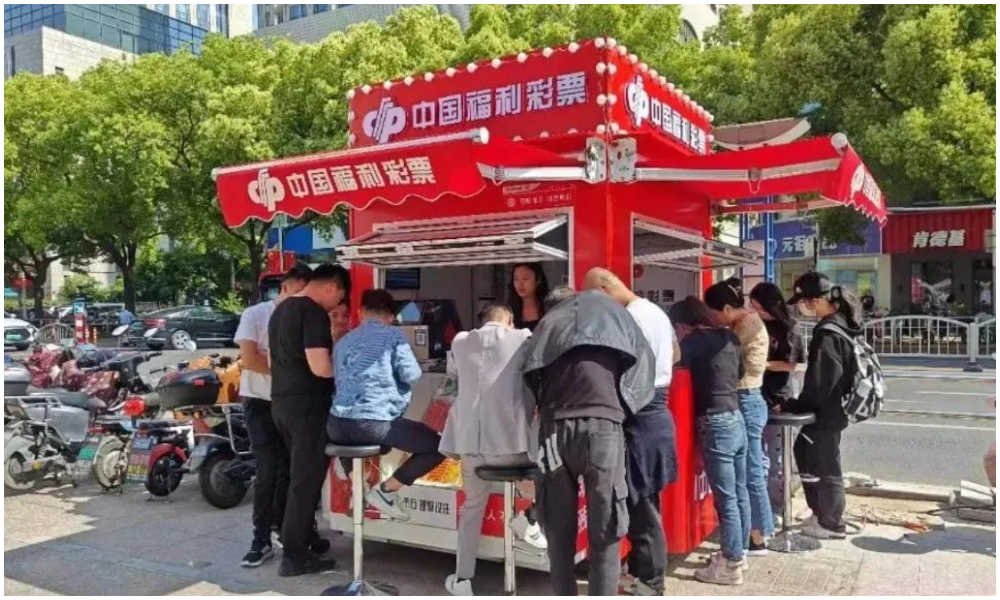
Image via The Paper
Some nucleic acid booths have now been turned into small shops selling lottery tickets for the China Welfare Lottery. One such place turning the kiosks into lottery shops is Songjiang in Shanghai.
Using the booths like this is a win-win situation: they are placed in central locations so it is more convenient for locals to get their lottery tickets, and on the other hand, the sales also help the community, as the profits are used for welfare projects, including care for the elderly.
10: Mini Fire Stations
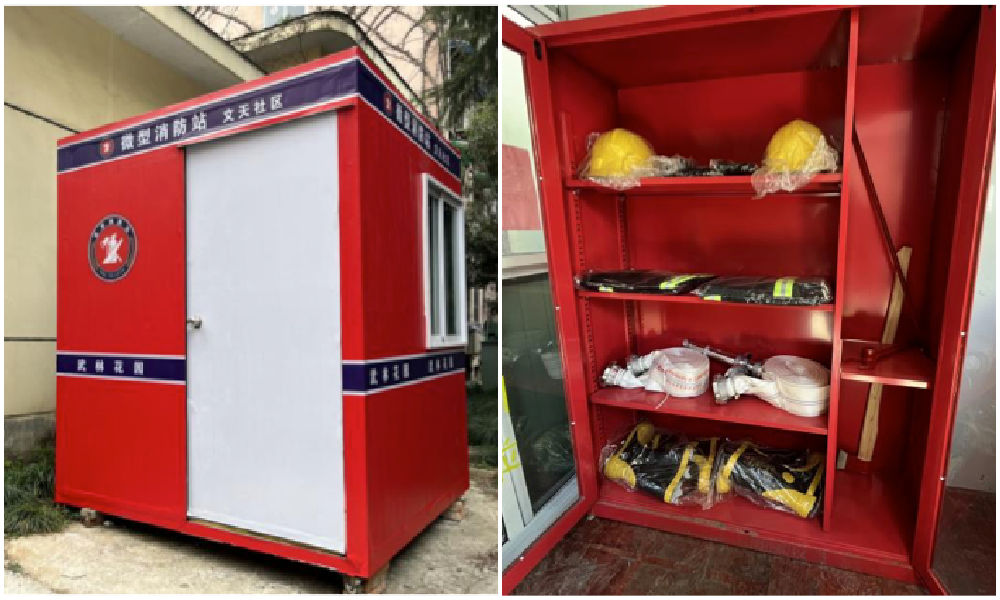
Micro fire stations, images via ZjNews.
Some communities decided that it would be useful to repurpose the testing points and turn them into mini fire kiosks, just allowing enough space for the necessary equipment to quickly respond to fire emergencies.
Want to read more about the end of ‘zero Covid’ in China? Check our other articles here.
By Manya Koetse,
Get the story behind the hashtag. Subscribe to What’s on Weibo here to receive our newsletter and get access to our latest articles:
Spotted a mistake or want to add something? Please let us know in comments below or email us. First-time commenters, please be patient – we will have to manually approve your comment before it appears.
©2023 Whatsonweibo. All rights reserved. Do not reproduce our content without permission – you can contact us at info@whatsonweibo.com.
Subscribe

Weibo Watch: The Future is Here

“Bye Bye Biden”: Biden’s Many Nicknames in Chinese

Enjoying the ‘Sea’ in Beijing’s Ditan Park

A Triumph for “Comrade Trump”: Chinese Social Media Reactions to Trump Rally Shooting

Weibo Watch: Get Up, Stand Up

The Tragic Story of “Fat Cat”: How a Chinese Gamer’s Suicide Went Viral

“Old Bull Eating Young Grass”: 86-Year-Old Chinese Painter Fan Zeng Marries 36-Year-Old Xu Meng

A Brew of Controversy: Lu Xun and LELECHA’s ‘Smoky’ Oolong Tea

Singing Competition or Patriotic Fight? Hunan TV’s ‘Singer 2024’ Stirs Nationalistic Sentiments

Zara Dress Goes Viral in China for Resemblance to Haidilao Apron

Weibo Watch: The Battle for the Bottom Bed

About the “AI Chatbot Based on Xi Jinping” Story

China’s Intensified Social Media Propaganda: “Taiwan Must Return to Motherland”

Weibo Watch: Telling China’s Stories Wrong

Saying Goodbye to “Uncle Wang”: Wang Wenbin Becomes Chinese Ambassador to Cambodia
Get in touch
Would you like to become a contributor, or do you have any tips or suggestions? Get in touch here!
Popular Reads
-

 China Insight3 months ago
China Insight3 months agoThe Tragic Story of “Fat Cat”: How a Chinese Gamer’s Suicide Went Viral
-

 China Music4 months ago
China Music4 months agoThe Chinese Viral TikTok Song Explained (No, It’s Not About Samsung)
-

 China Digital10 months ago
China Digital10 months agoToo Sexy for Weibo? Online Discussions on the Concept of ‘Cābiān’
-

 China Arts & Entertainment12 months ago
China Arts & Entertainment12 months agoBehind 8 Billion Streams: Who is Dao Lang Cursing in the Chinese Hit Song ‘Luocha Kingdom’?




